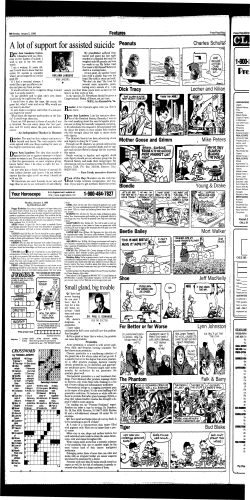
PROSTATITIS BASIC INFORMATION DESCRIPTION
Information From Your Health Care Provider PROSTATITIS BASIC INFORMATION DESCRIPTION Inflammation of the prostate. The prostate is about the size of a walnut and is located just below the urinary bladder in men. Inflammation causes swelling of the prostate. The swelling can occur gradually or come on suddenly. Symptoms occur when the swollen prostate presses against the urethra. This is the tube that carries urine from the bladder outside. Prostatitis is a common disorder in adult males. Types include: Acute bacterial prostatitis. Chronic bacterial prostatitis. Chronic nonbacterial prostatitis/chronic pelvic pain syndrome. Asymptomatic prostatitis. FREQUENT SIGNS AND SYMPTOMS Urgency to urinate. Burning or pain with urination. Frequent urination. Waking at night to urinate. Difficulty starting urination and emptying the bladder completely. Fever, chills, tiredness, and muscle and joint aches. Pain between the scrotum and anus. Blood in the urine (sometimes) or in the semen. Low back pain. Inability to enjoy sex; unable to get and maintain an erection. CAUSES Acute and chronic bacterial types are caused by bacteria infection. In some cases, it is sexually transmitted. In nonbacterial types, the causes are unclear. It is neither contagious nor infectious, and it does not cause cancer. RISK INCREASES WITH Urinary-tract infection or sexually transmitted disease. Diabetes. Weak immune system due to illness or drugs. Use of a catheter (tube to remove urine) after surgery. PREVENTIVE MEASURES None specific. Avoid infections and sexually transmitted diseases. EXPECTED OUTCOMES Outcome is generally good for bacterial prostatitis. Treatment may take weeks or longer and different drugs may be tried. Other types can be more difficult to treat, and the outcomes will vary. POSSIBLE COMPLICATIONS Prostatitis often recurs. Chronic prostatitis. Abscess (pus-filled infection). Bladder obstruction and urinary retention. Urinary-tract infection. Infertility. Blood poisoning. DIAGNOSIS & TREATMENT GENERAL MEASURES Your health care provider will do a digital rectal exam (DRE). During a DRE, a gloved, lubricated finger is inserted into the rectum to feel the prostate gland's size and to check for lumps. Medical tests may include urinalysis and a culture of secretions obtained at the time of the DRE exam. Treatment may include drugs, lifestyle changes, hospital care, counseling, and rarely, surgery. To relieve discomfort, sit in a tub with 6 to 8 inches of warm water for 15 minutes at least 3 times a day. Use an inflatable donut cushion for sitting. Counseling may help with stress or sexual dysfunction problems. Support groups may help some patients. Hospital care may be needed for severe symptoms. Ejaculating every 3 days or prostatic massage may help drain excess prostate fluid. Ask your health care provider about these options. Rarely, surgery to drain an abscess of the prostate or to remove the prostate if other treatment fails. MEDICATIONS Your health care provider may prescribe: Antibiotics for bacterial infection. In severe cases, they may be given through a vein (IV). Take the full course of antibiotics to help prevent recurrence. Nonsteroidal anti-inflammatory drugs for pain. Steroids for inflammation. Drugs to help improve bladder or prostate function. Tranquilizers, if stress is a concern. Stool softeners to avoid constipation. ACTIVITY Stay active. Walking is a good exercise if it doesn't cause pain. You will be advised about sexual activity limits. DIET Avoid alcohol, coffee, and spicy foods. These irritate the urethra. Drink plenty of fluids. NOTIFY OUR OFFICE IF You or a family member has symptoms of prostatitis. Symptoms don't improve after 3 days of treatment.
© Copyright 2025





















